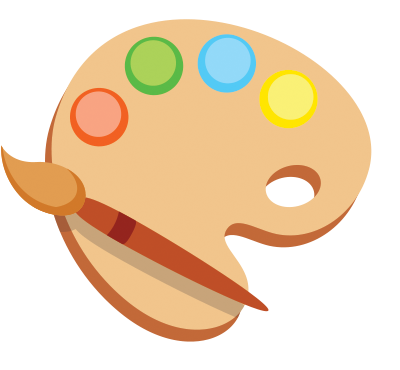Painting With Soil
Adapted from a Natural Resources Conservation Service educational activity, Painting with Soil. This lesson is recommended for a group of less than 20 students.
Summary
Soils come in many colors that add beauty to the natural world around us, and this colorful array of soils can even be used to create paints and beautiful paintings.
Learning Objective
To discover the beauty in the variety of colored soils around the world.
Curriculum Connections
Science: Earth Science - types of soil
Technology: Using tools to create the paint: Using computers to view works of art created with soils and to research soils across the state and country
Engineering: Problem solving how to turn the soils into paint
Arts: This lesson uses creativity, color and design to create a finished product
Math: Measurement and Ratio
Estimated Time
1 to 2 hours
Materials
Different colored soil samples (air dried)
Hammer or mallet
Mortar and pestle
Paper or paper plates
Paper cups (4 oz)
Nylon stockings or sieves
Pencils
Black ink pens
Paint brushes (different kinds and sizes)
Clear craft glue
Sponges and rags
Cardstock
Masking tape
Methods/Procedures
Preparing the Soils
Collect soil samples in a variety of colors. Soils can be found that are brown, black, red, orange, yellow, grey, even blue or green. Air dry on aluminum foil or paper plates.
Place dried soil on a piece of paper or paper plate and crush with a hammer or mallet.
Place some of the crushed soil into a mortar. Use the pestle to further crush the soil into a fine powder.
Repeat to crush all of the different colored soils.
Sieve the soils. Place the powdered soil in a paper cup. Wrap a knee-high stocking over the top two or three times. Turn the cup upside down over a piece of paper or paper plate and gently shake out finely powdered soil.
Store the different soils in paper cups— notice the colors and textures.
Painting
Lightly sketch a drawing on watercolor paper with a pencil. Then trace the lines with ink for permanent lines.
Use masking tape to carefully tape the edges of the paper to the table or easel. This will allow the artwork to dry flat.
Pour a small amount of artist acrylic or Elmer’s glue in small paper cups. Add a small amount of finely powdered soil to the acrylic. You may also want to add a few drops of water to the soil mix.
Experiment with the depth of color by adding more or less soil and create new colors by mixing different soils.
Use different sizes and kinds of paint brushes, sponges, or rags to apply the soil paint to your “canvas.” Experiment and have fun.
When your artwork is dry, you may want to apply another layer of soil paint.
You can also use a black ink pen to make finishing touches on your artwork.
Discussion Questions
• What causes this variety of colors in soils?
ANSWER: Soils with high amounts of organic matter are darker, even black. Soils with high amounts of lime are white. Red or orange soils have lots of iron. Soils with a green tinge have higher amounts of copper. Yellow soils usually come from sandstone.
• How do soil scientists talk about soil colors?
Literacy and Social Studies Extension
Have students use technology to find schools around the state. Next, divide the class into groups and have them write to those schools explaining that they are researching the different colors of soil around the state and what composes the soil.
Ask the pen pal schools to send samples of soil from their area and to tell what kind of crops or plants are commonly grown there.
When the samples come in, students should label and catalog the soils. A large laminated map of the state would be a good way visualize how soils differ in different areas of the state. Glue a small amount of soil onto the map to show where it was from.
Students may write thank you notes to schools who participated in the project and may also share their results.
Additional Resources
A soil color matching game is available at the Smithsonian’s National Museum of Natural History Forces of Change website - http://forces.si.edu/soils/02_02_03.html
Jan Lang, an NRCS technician, has painted a series of canvases portraying the Lewis and Clark expedition. See these images at http://www.nrcs.usda.gov/wps/portal/nrcs/detail/national/soils/?cid=nrcs142p2_054282

